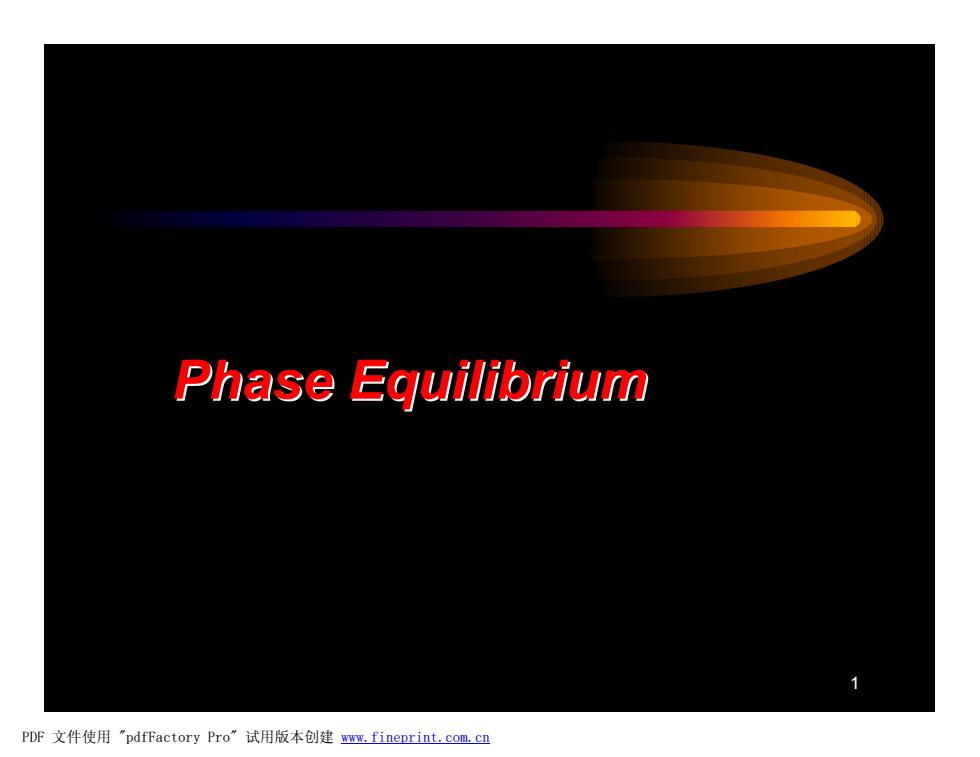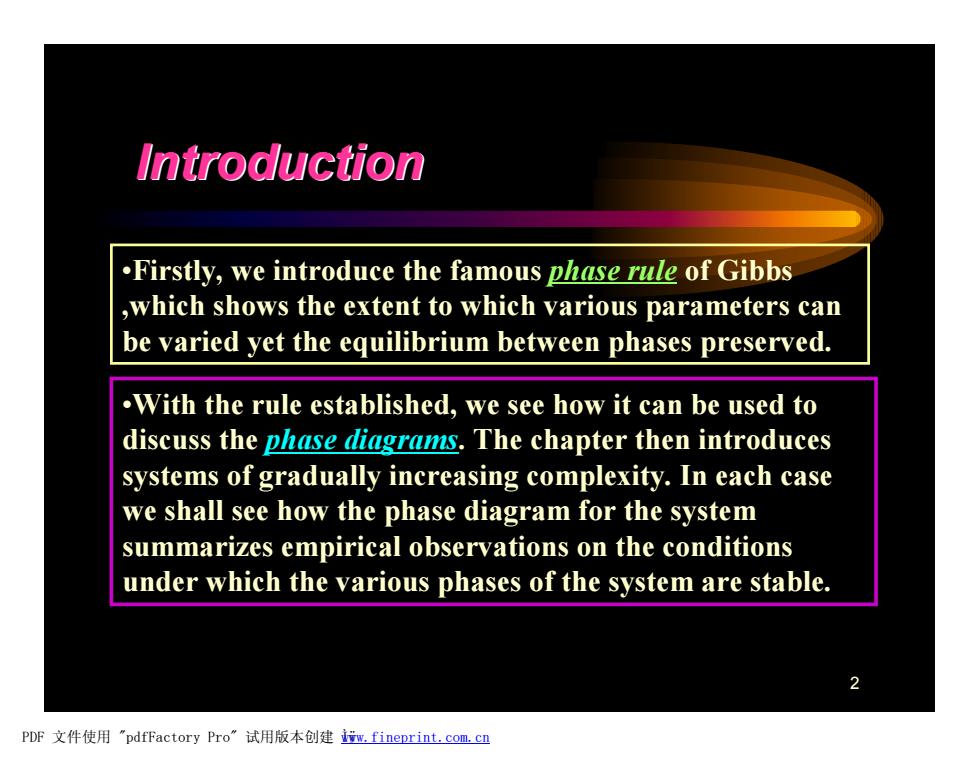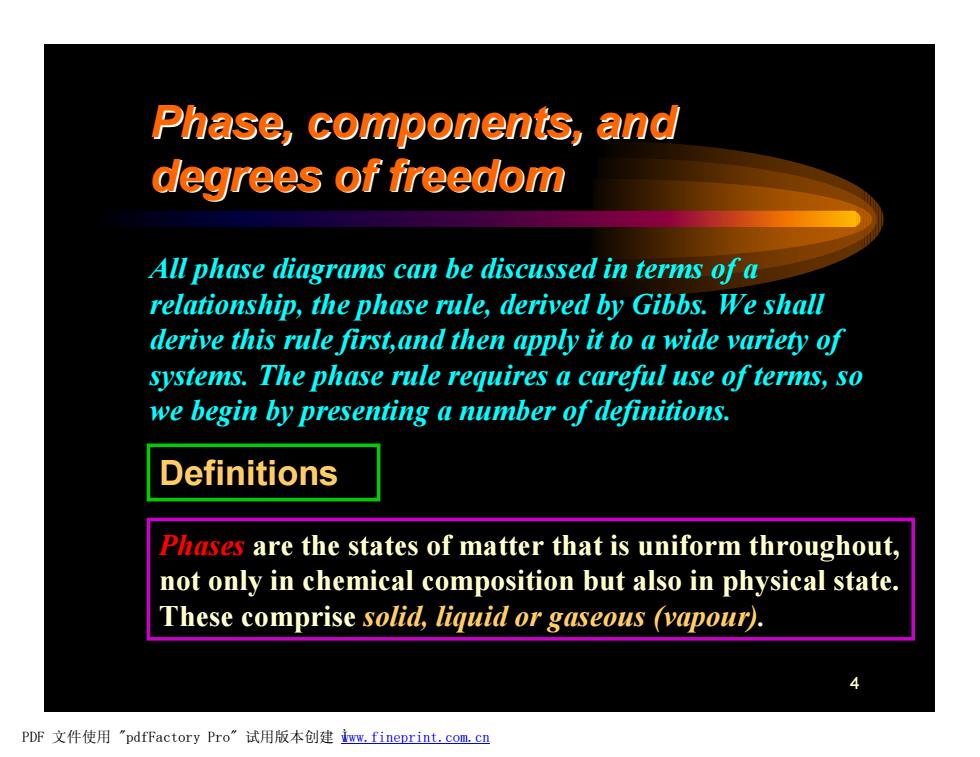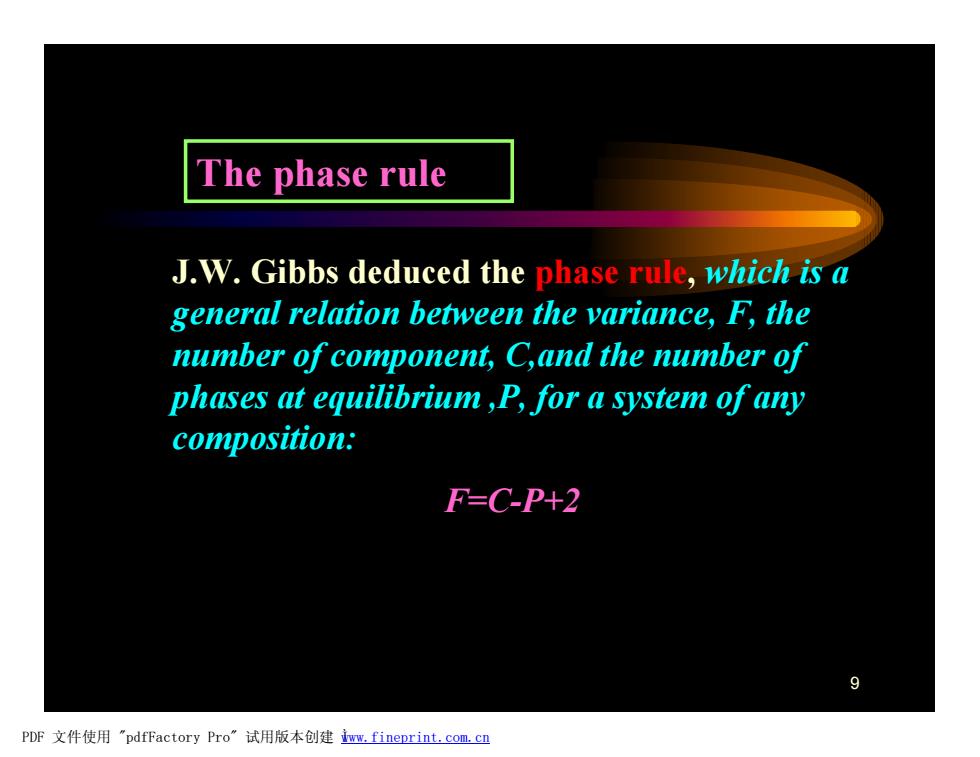
Phase Equilibrium 1 PDF文件使用"pdfFactory Pro”试用版本创建mm,fineprint.com,cn
1 Phase Equilibrium PDF 文件使用 "pdfFactory Pro" 试用版本创建 www.fineprint.com.cn

Introduction .Firstly,we introduce the famous phase rule of Gibbs which shows the extent to which various parameters can be varied yet the equilibrium between phases preserved. .With the rule established,we see how it can be used to discuss the phase diagrams.The chapter then introduces systems of gradually increasing complexity.In each case we shall see how the phase diagram for the system summarizes empirical observations on the conditions under which the various phases of the system are stable. 2 PDF文件使用"pdfFactory Pro”试用版本创建m,fineprint.com,cn
2 Introduction •Firstly, we introduce the famous phase rule of Gibbs ,which shows the extent to which various parameters can be varied yet the equilibrium between phases preserved. •With the rule established, we see how it can be used to discuss the phase diagrams. The chapter then introduces systems of gradually increasing complexity. In each case we shall see how the phase diagram for the system summarizes empirical observations on the conditions under which the various phases of the system are stable. PDF 文件使用 "pdfFactory Pro" 试用版本创建 Ìwww.fineprint.com.cn ÿ

Introduction .Why to learn this chapter? Phase diagrams are of considerable commercial and industrial significance,particularly for semiconductors, ceramics,steels,and alloys.They are also the basis of separation procedures in the petroleum industry and of the formulation of foods and cosmetic preparations. 3 PDF文件使用"pdfFactory Pro”试用版本创建wm,fineprint.com,cn
3 Introduction •Why to learn this chapter? Phase diagrams are of considerable commercial and industrial significance, particularly for semiconductors, ceramics, steels, and alloys. They are also the basis of separation procedures in the petroleum industry and of the formulation of foods and cosmetic preparations. PDF 文件使用 "pdfFactory Pro" 试用版本创建 Ìwww.fineprint.com.cn

Phase,components,and degrees of freedom All phase diagrams can be discussed in terms of a relationship,the phase rule,derived by Gibbs.We shall derive this rule first,and then apply it to a wide variety of systems.The phase rule requires a careful use of terms,so we begin by presenting a number of definitions Definitions Phases are the states of matter that is uniform throughout, not only in chemical composition but also in physical state. These comprise solid,liquid or gaseous (vapour). PDF文件使用"pdfFactory Pro”试用版本创建m,fineprint.com,c四
4 Phase, components, and degrees of freedom All phase diagrams can be discussed in terms of a relationship, the phase rule, derived by Gibbs. We shall derive this rule first,and then apply it to a wide variety of systems. The phase rule requires a careful use of terms, so we begin by presenting a number of definitions. Definitions Phases are the states of matter that is uniform throughout, not only in chemical composition but also in physical state. These comprise solid, liquid or gaseous (vapour). PDF 文件使用 "pdfFactory Pro" 试用版本创建 Ìwww.fineprint.com.cn

The number of phases in a system is denoted P (a)A gas,or a gaseous mixture is a single phase. P=1 (b)For a solid system,an alloy of two metals is a two-phase system(P=2)if the metals are immiscible,but a single-phase system(P=1)if they are miscible---a homogeneous mixture of the two substances---is uniform on a molecular scale. 5 PDF文件使用"pdfFactory Pro”试用版本创建ww,fineprint.com,cn
5 The number of phases in a system is denoted P (a)A gas, or a gaseous mixture is a single phase. P=1 (b) For a solid system, an alloy of two metals is a two-phase system(P=2) if the metals are immiscible, but a single-phase system(P=1) if they are miscible---a homogeneous mixture of the two substances---is uniform on a molecular scale. PDF 文件使用 "pdfFactory Pro" 试用版本创建 fwww.fineprint.com.cn

(c)For a liquid system,according to the solubility to decide whether a system consists of one phase or of two.For example,a solution of sodium chloride in water is a single phase.A pair of liquids that are partially miscible is a two-phase system(P=2) CaCO3(s)CaO(s)+CO,(g) Phase 1 Phase 2 Phase 3 6 PDF文件使用"pdfFactory Pro”试用版本创建fm,fineprint.com,cn
6 (c) For a liquid system, according to the solubility to decide whether a system consists of one phase or of two. For example, a solution of sodium chloride in water is a single phase. A pair of liquids that are partially miscible is a two-phase system(P=2) CaCO3 (s) F CaO(s) + CO2 (g) Phase 1 Phase 2 Phase 3 PDF 文件使用 "pdfFactory Pro" 试用版本创建 fwww.fineprint.com.cn

Species---means a chemical species(an ion or a molecular)that is present,denoted Component---The number of component is the minimum number ofindependent species necessary to define the composition of all the phase present in the system,denoted C. Usually C≤S (a)When the species do not react,C=S (b)If the species do react,and are at equilibrium, C=S-R R---the number of independent reactions PDF文件使用"pdfFactory Pro”试用版本创建ww,fineprint.com,cn
7 Species--- means a chemical species(an ion or a molecular) that is present, denoted S. Component---The number of component is the minimum number of independent species necessary to define the composition of all the phase present in the system, denoted C. Usually C≤S (a) When the species do not react, C=S (b) If the species do react, and are at equilibrium, C=S-R R---the number of independent reactions PDF 文件使用 "pdfFactory Pro" 试用版本创建 fwww.fineprint.com.cn

(c)The limited concentration in the same phase R'---the number of concentration limitation C=S-R-R' Note:S can be different according to your opinion,but C is only one for a given system. Degrees of freedom---is the number ofintensive variables that can be changed independently without disturbing the number of phases in equilibrium.denoted F. 8 PDF文件使用"pdfFactory Pro”试用版本创建m,fineprint.com,cn
8 (c) The limited concentration in the same phase R’---the number of concentration limitation C=S-R-R’ Degrees of freedom---is the number of intensive variables that can be changed independently without disturbing the number of phases in equilibrium. denoted F. Note: S can be different according to your opinion, but C is only one for a given system. PDF 文件使用 "pdfFactory Pro" 试用版本创建 Ìwww.fineprint.com.cn

The phase rule J.W.Gibbs deduced the phase rule,which is a general relation between the variance,F,the number of component,C,and the number of phases at equilibrium,P,for a system of any composition: F=C-P+2 9 PDF文件使用"pdfFactory Pro”试用版本创建wm,fineprint.com,cn
9 The phase rule J.W. Gibbs deduced the phase rule, which is a general relation between the variance, F, the number of component, C,and the number of phases at equilibrium ,P, for a system of any composition: F=C-P+2 PDF 文件使用 "pdfFactory Pro" 试用版本创建 Ìwww.fineprint.com.cn

Deduce the phase rule F=the total number of intensive variables the total number ofrelations Suppose:there are S species in every phase for P Phases Intensive variables:T,P,count as 2;there are S species in every phase for P Phases,so the total number of intensive variables is PS+2. Relations:because Exg=1 in every phase and there is P phases and He(1)=uB(2)=g(3)--B(P),the total number is S(P-1);there are R independent reactions and R'concentration limitations the total number of relations is P+S(P-1)+R+R So F=(PS+2)-/P+S(P-1)+R+RJ=S-R-R-P+2 F=C-P+2 10 PDF文件使用"pdfFactory Pro”试用版本创建wmw,fineprint.com,c四
10 Deduce the phase rule F=the total number of intensive variables-the total number of relations Suppose:there are S species in every phase for P Phases Intensive variables:T,P,count as 2; there are S species in every phase for P Phases,so the total number of intensive variables is PS+2. Relations:because ∑xB =1 in every phase and there is P phases ;and mB (1)=mB (2)=mB (3)=┄= mB (P),the total number is S(P-1);there are R independent reactions and R¢ concentration limitations the total number of relations is P+S(P-1)+R+R¢ So F=(PS+2)-[P+S(P-1)+R+R¢]=S-R-R¢-P+2 F=C-P+2 PDF 文件使用 "pdfFactory Pro" 试用版本创建 Ìwww.fineprint.com.cn